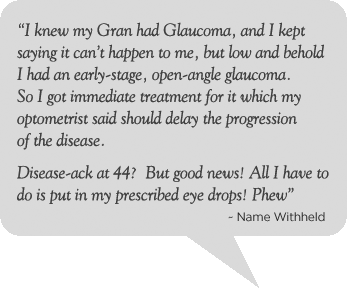What Is a Glaucoma Test?
Glaucoma is the generalized name for a group of eye diseases that damage the optic nerve of the eye, preventing the eye from sending accurate visual information to the brain. Glaucoma tests are designed to test your eyes for one of the key symptoms of the disease—increased eye pressure—however only a comprehensive eye exam can reveal whether or not you have glaucoma. Increased pressure inside the eye is often a key indicator of glaucoma, though not exclusively so. Eye doctors can use a number of tests for eye pressure, but will, by default, check for signs of glaucoma as part of a detailed examination of the retina—the light sensitive area at the back of the eye responsible for processing images.

How Does Glaucoma Testing Work?
A glaucoma test is usually part of a routine eye exam in the Woodlands and our five additional Eye Trends locations. Both types of glaucoma tests measure internal pressure of the eye.
One glaucoma test involves measuring what happens when a puff of air is blown across the surface of the eye. (A puff test) Another test uses a special device (in conjunction with eye-numbing drops) to “touch” the surface of the eye to measure eye pressure.
While increased eye pressure is a key indicator of the disease, it does not necessarily mean you have a glaucoma diagnosis. In fact, the only way to detect glaucoma is to have a detailed, comprehensive eye exam that often includes dilation of the pupils.
So “true” glaucoma testing actually involves examining the retina and optic nerve at the back of the eye for signs of the disease.
Glaucoma Treatment
Depending on the severity of the disease, treatment for glaucoma can involve the use of medications, conventional (bladed) surgery, laser surgery or a combination of these treatments. Medicated eye drops aimed at lowering IOP usually are tried first to control glaucoma.
Because glaucoma is often painless, people may become careless about strict use of eye drops that can control eye pressure and help prevent permanent eye damage. In fact, non-compliance with a program of prescribed glaucoma medication is a major reason for blindness resulting from glaucoma.
If you find that the eye drops you are using for glaucoma are uncomfortable or inconvenient, never discontinue them without first consulting your eye doctor about a possible alternative therapy.
All glaucoma surgery procedures (whether laser or non-laser) are designed to accomplish one of two basic results: decrease the production of intraocular fluid or increase the outflow (drainage) of this same fluid. Occasionally, a procedure will accomplish both.
Currently the goal of glaucoma surgery and other glaucoma therapy is to reduce or stabilize intraocular pressure (IOP). When this goal is accomplished, damage to ocular structures – especially the optic nerve – may be prevented.
Learn More
Glaucoma can cause slight to severe vision loss, and is often discovered only after the disease is present—that’s why glaucoma testing is so important.
- Read more about the causes, symptoms and treatment options for glaucoma.
- Cataracts are also common cause of vision loss after age 55. Click to learn more.
Special thanks to the EyeGlass Guide for informational material that aided in the creation of this website.
